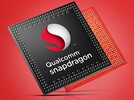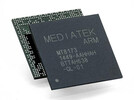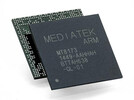Qualcomm Snapdragon 415 MSM8929 vs Mediatek MT8173C vs Mediatek MT8173
Qualcomm Snapdragon 415 MSM8929
► remove from comparison
The Qualcomm Snapdragon 415 (8929) is an ARM-based mid-range SoC for tablets and smartphones (mostly Android based). It was announced in February 2015 and integrates eight 64-Bit Cortex-A53 CPU cores (octa-core) that clock with up to 1.4 GHz. Furthermore, there is a Adreno 405 graphics card, a LPDDR3 memory controller (max. 667 MHz, 5.3 GB/s) and wireless radios for WiFi and 4G/LTE included in the chip.
The Cortex-A53 is the successor of the entry level Cortex-A7 CPU cores. The A53 is now capable of 64 Bit (ARMv8-ISA) and adressing more than 4 GB RAM. According to ARM the performance per MHz is a lot better and even surpasses a Cortex-A9 core.
The integrated Adreno 405 is clocked with about 500 MHz and supports DirectX 11.1 incl. hardware Tesselation, OpenGL ES 3.1 and OpenCL 1.2.
The integrated wireless radios support WiFi 802.11ac, Bluetooth 4.1, GPS, 2G, 3G and 4G (LTE Cat.4) standards. Futhermore, the SoC is able to decode 1080p videos in H.265 (encode only in H.264) and cameras with up to 13 MP.
The power consumption of the chip is ranging in the mid range, and therefore it is also suited for smaller smartphones.
Mediatek MT8173C
► remove from comparison
The Mediatek MT8173C is an upper mainstream ARM SoC (System on a chip) that was introduced in March 2015 and is primarily used for Android based tablets and Chromebooks. It is manufactured in a 28 nm process and has a total of four CPU cores with two Cortex-A72 and two Cortex-A53 cores in a big.LITTLE configuration. The graphics unit is based on the IMG Series 6XT (Rogue) and has the designation PowerVR GX6250. Among others, the GPU includes a video decoder with 4K and H.265 support.
Processor
The biggest highlight of the SoC are the new Cortex-A72 cores, which can be seen as the successors to the Cortex-A57 design. ARM promises much more performance in combination with reduced power consumption, which results in an excellent per-thread performance with the very high maximum clock of 2.4 GHz. The architecture is based on ARMv8-ISA and therefore supports 64-bit.
The two slower, but therefore very frugal Cortex-A53 cores (clocks unknown, probably around 1.5 GHz) are supposed to reduce the power consumption and are always active with light workloads. The big.LITTLE configuration also allows the simultaneous use of all four cores (or any combination of cores from both clusters), so the MT8173C can be called a real quad-core.
Graphics
The graphics unit is based on Series 6XT (Rogue) from IMG and has the designation PowerVR GX6250. The 2-cluster chip has a unified-shader architecture with a total of 64 FP32 ALUs as well as 4 TMUs. Thanks to the comparatively high maximum clock of 700 MHz, the performance is roughly on par with the PowerVR G6430 in the iPhone 5s. High-resolution screens and complex Android games from 2015 are usually no problem for the GPU.
Features
Besides CPU and GPU, the chip is also equipped with an LPDDR3 memory controller (2x 32-bit, probably up to 933 MHz, 14.9 GB/s), but no wireless modem. The maximum display resolution is 2560 x 1600 pixels. Another highlight is the integrated video engine, which even supports 4K material and the modern H.265 codec.
Power Consumption
The MT8173 is manufactured in an 28 nm process and should have a average up to high power consumption. It can still be used in tablets and laptops without limitations.
Mediatek MT8173
► remove from comparison
The Mediatek MT8173 is an upper mainstream ARM SoC (System on a chip) that was introduced in March 2015 and is primarily used for Android based tablets. It is manufactured in a 28 nm process and has a total of four CPU cores with two Cortex-A72 and two Cortex-A53 cores in a big.LITTLE configuration. The graphics unit is based on the IMG Series 6XT (Rogue) and has the designation PowerVR GX6250. Among others, the GPU includes a video decoder with 4K and H.265 support.
Processor
The biggest highlight of the SoC are the new Cortex-A72 cores, which can be seen as the successors to the Cortex-A57 design. ARM promises much more performance in combination with reduced power consumption, which results in an excellent per-thread performance with the very high maximum clock of 2.4 GHz. The architecture is based on ARMv8-ISA and therefore supports 64-bit.
The two slower, but therefore very frugal Cortex-A53 cores (clocks unknown, probably around 1.5 GHz) are supposed to reduce the power consumption and are always active with light workloads. The big.LITTLE configuration also allows the simultaneous use of all four cores (or any combination of cores from both clusters), so the MT8173 can be called a real quad-core.
Graphics
The graphics unit is based on Series 6XT (Rogue) from IMG and has the designation PowerVR GX6250. The 2-cluster chip has a unified-shader architecture with a total of 64 FP32 ALUs as well as 4 TMUs. Thanks to the comparatively high maximum clock of 700 MHz, the performance is roughly on par with the PowerVR G6430 in the iPhone 5s. High-resolution screens and complex Android games from 2015 are usually no problem for the GPU.
Features
Besides CPU and GPU, the chip is also equipped with an LPDDR3 memory controller (2x 32-bit, probably up to 933 MHz, 14.9 GB/s), but no wireless modem. The maximum display resolution is 2560 x 1600 pixels. Another highlight is the integrated video engine, which even supports 4K material and the modern H.265 codec.
Power Consumption
The MT8173 is manufactured in an 28 nm process and should have a average up to high power consumption. It can still be used in tablets without limitations.
| Model | Qualcomm Snapdragon 415 MSM8929 | Mediatek MT8173C | Mediatek MT8173 | ||||||||||||||||||||||||||||||||||||||||||||||||||||||||||||||||||||||||||||||||||||||||
| Series | Qualcomm Snapdragon | Mediatek | Mediatek | ||||||||||||||||||||||||||||||||||||||||||||||||||||||||||||||||||||||||||||||||||||||||
| Codename | Cortex-A53 | Cortex-A72/-A53 | Cortex-A72/-A53 | ||||||||||||||||||||||||||||||||||||||||||||||||||||||||||||||||||||||||||||||||||||||||
| Series: Mediatek Cortex-A72/-A53 |
|
|
| ||||||||||||||||||||||||||||||||||||||||||||||||||||||||||||||||||||||||||||||||||||||||
| Clock | 1400 MHz | 2100 MHz | 2400 MHz | ||||||||||||||||||||||||||||||||||||||||||||||||||||||||||||||||||||||||||||||||||||||||
| Cores / Threads | 8 / 8 | 4 / 4 | 4 / 4 | ||||||||||||||||||||||||||||||||||||||||||||||||||||||||||||||||||||||||||||||||||||||||
| Technology | 28 nm | 28 nm | 28 nm | ||||||||||||||||||||||||||||||||||||||||||||||||||||||||||||||||||||||||||||||||||||||||
| Features | Adreno 405 GPU, WLAN 802.11ac, Bluetooth 4.1, GSM/EDGE, WCDMA, UMTS/HSPA, LTE Cat. 4 (max. 150 Mbps), GPS (Qualcomm IZat Gen8C Lite), LPDDR3-1333 Memory Controller | 20 MP Camera ISP, 4K Video Encoder, H.265, PowerVR GX6250 GPU | 20 MP Camera ISP, 4K Video Encoder, H.265, PowerVR GX6250 GPU | ||||||||||||||||||||||||||||||||||||||||||||||||||||||||||||||||||||||||||||||||||||||||
| iGPU | Qualcomm Adreno 405 | PowerVR GX6250 (? - 700 MHz) | PowerVR GX6250 (? - 700 MHz) | ||||||||||||||||||||||||||||||||||||||||||||||||||||||||||||||||||||||||||||||||||||||||
| Architecture | ARM | ARM | ARM | ||||||||||||||||||||||||||||||||||||||||||||||||||||||||||||||||||||||||||||||||||||||||
| Announced | |||||||||||||||||||||||||||||||||||||||||||||||||||||||||||||||||||||||||||||||||||||||||||
| Manufacturer | www.qualcomm.com |


 Deutsch
Deutsch English
English Español
Español Français
Français Italiano
Italiano Nederlands
Nederlands Polski
Polski Português
Português Русский
Русский Türkçe
Türkçe Svenska
Svenska Chinese
Chinese Magyar
Magyar
